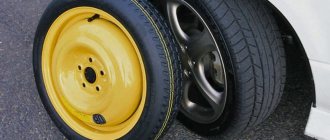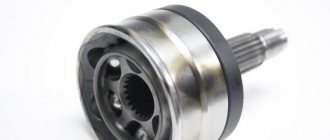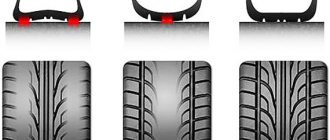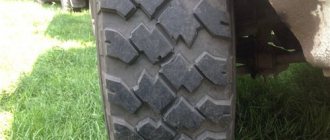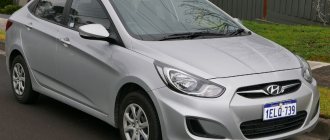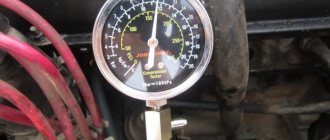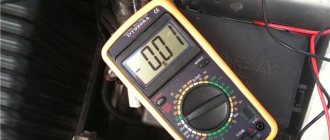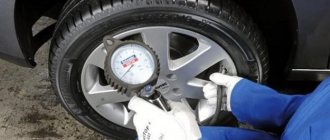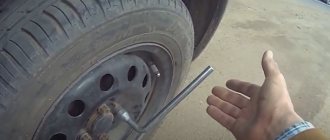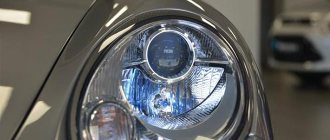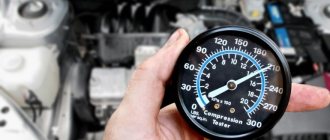Each winter tire is marked M S. It is also found on some summer tires, which many drivers classify as all-season tires. However, this is not entirely correct. For example, most SUV tires or tires sold on the American market are labeled M+C, but do not always meet the needs of drivers in winter conditions. Let's figure it out.
Explanation of the designation
M+S on tires is an abbreviation of the English words Mud + Snow , which translates as “mud and snow” . The marking is located on the sidewall of the tire.
The M+S designation indicates that the tires are all-season. Such tires may be marked with other symbols depending on the manufacturer:
- AS (All Season);
- AW (Any Weather);
- R+W (Road+Winter);
- graphic sign “sun/snowflake”.
The listed designations say the same thing; they indicate increased traction qualities of tires on snow and mud . But this does not mean at all that such tires will be an equivalent replacement for winter tires.
Attention! For not a single type of tire labeled as all-season, there is no confirmation or regulatory framework of their suitability for winter conditions. The manufacturer has the right to mark any tires with the letters M+S for advertising purposes.
The suitability of the product for extreme climatic conditions is only confirmed by the 3PMSF designation. This is an icon of a snowflake inscribed in a mountain. Only he guarantees that the rubber is designed for driving at low temperatures.
May be interesting: What is rolling resistance coefficient
American tire markings
American designations
In the United States, passenger car tires are labeled differently than in Europe and the post-Soviet countries.
For example, it may look like: 30 x 9.5R 16 LT
It can be decrypted as follows:
- 30 — external size (wheel diameter in inches);
- 9,5 — tire width (also in inches);
- R - radial intersection of cord threads;
- 16 — internal diameter (in inches);
- LT – what kind of transport is it suitable for? In this case, it is a commercial vehicle (LightTruck).
Advantages and disadvantages of this rubber
Before purchasing all-season tires, it is advisable to find out what advantages and disadvantages they have.
Advantages of tires labeled M+S:
- Versatility. All-season tires are suitable for a wide range of weather conditions.
- Quiet ride. Due to the absence of spikes and a pronounced tread pattern, there is no noise coming from the rubber when driving.
- Increased softness compared to summer and winter models. The low degree of tire rigidity provides increased comfort while driving.
- Possibility of using one set of tires for each season. This significantly reduces the cost of seasonal tires and tire fitting services.
- Resistance to wear and tear due to adverse weather conditions ensures longer service life.
Carefully! While there are many advantages, all-season tires have a number of limitations and are not suitable for some weather conditions.
Disadvantages of tires marked with the M+S badge:
- M+S tires are definitely not winter or summer tires: they do not withstand climate extremes. The manufacturer recommends them as all-season, but they lose a significant part of their declared characteristics at temperatures below -7 and above +20 degrees.
- In hot weather, such rubber softens, resulting in increased fuel consumption.
- Poor traction on too wet roads.
- In cold weather, the M+S tire becomes dull and braking performance is reduced by more than 2 times.
- On a snowy road, due to the lack of a large tread, it can slip.
- The price of all-season tires is higher than that of summer tires.
A temperate climate is suitable for this type of tire, where it will serve for a long time without causing problems.
Useful to read: What is better in winter – Velcro or spikes
M+S tire marking is not only for winter
Tires M + S: choose by marking
The more choices there are, the more difficult it is to make a decision. Car tires are no exception, as there are many options on the market. Not everyone knows, but tires “have” special markings, and in this material we will pay attention to M + S and 3PMSF tires, which are suitable for year-round use in regions with warm winters.
Tires M + S. Where to look for markings
When choosing tires, car owners usually pay attention to cost, brand, tread pattern, and the presence or absence of studs. If you look at the tire from a different angle - from the side, then on the sidewall you can see a set of numbers, letters and even drawings that sometimes tell more about the tire than a consultant at a car dealership. Among them will be indicated: manufacturer, country of production, model name, size, speed and load indexes, tube type and other technical features of a particular tire. Some models intended for winter use may be marked 3PMSF (mountain or snowflake symbols) or the designation of mud and snow - you will see M + S on the tire. These letters can confuse even experienced motorists, not to mention beginners. It's worth noting that some drivers call MS and 3PMSF tires "all-season", which is only true under certain conditions.
Tires M S. What does it mean?
Tires marked M+S have been on the market for more than 50 years and even seem a little romantic due to the set of letters and symbol. But in fact, these are the first letters taken from the English phrase MudandSnow, which translated means “Mud and Snow.” Thus, the manufacturer reports that the tire provides better traction. That is, the main advantage of M + S tires over other winter tires is the ability to more easily overcome dirty, snow-covered (not to be confused with snowdrifts and ice) roads, in other words, “winter mess”. Accordingly, such tires will perform well in the off-season and in rainy summers somewhere outside the city, or in regions where changes in weather conditions are not as noticeable as in the northern zone. That is why in our country, M + S and 3PMSF tires are most often chosen for year-round use by residents of the Southern and North Caucasus federal districts.
M + S tires will be a godsend for off-road enthusiasts, because the softer rubber compound provides better grip on the road, eliminating the possibility of the wheels coming off the road surface. Rolling resistance also increases. In such tires, layers of rubber are laid diagonally in different directions, due to which stability is achieved on imperfect roads.
What is special about M+S tires?
Manufacturers have introduced M+S (MudandSnow) tire markings to simplify the identification of winter models. But not all tires are winter. Yes, M + S tires perform better in snow compared to summer tires, their tread has many sipes and resembles Velcro, but M + S tires do not always pass the snow test and cannot ensure safe driving on winter roads . That is, some manufacturers position tires labeled M+S as all-season, but only the car owner can assess the weather conditions of his region and understand whether such tires are suitable for him in any season or not. As you know, it is necessary to “change shoes” of a car starting from 5-7 degrees. M + S tires are not resistant to low temperatures, and at temperatures below 7 degrees they will behave on the road just like summer tires.
If the tire has M + S, this means that in the production of the model a rubber compound is used, the operating temperature range of which is wider than that of summer tires.
So which tires are still considered winter?
Tires M + S and 3PMSF: Winter, where there is “snow and mountains”
In accordance with the Decree “On the Safety of Motor Vehicles” in 2012, the mandatory designation 3PMSF (ThreePeakMountainSnowFlake) was introduced for winter tires - the so-called “Alpine symbol”, an image of mountains with a snowflake. This means that the tires are more flexible at low temperatures and have been tested on snowy roads and meet the technical and safety requirements for winter tires. Such tires are tested in conditions of low temperatures and show excellent results in terms of basic parameters - braking and traction in difficult weather conditions. The criteria for tire compliance with declared international standards are checked by independent experts. The 3PMSF mark has been approved at the legislative level.
By the way, according to the law of the Russian Federation, in the winter (December, January, February), owners of category B cars are required to use winter tires marked M+S and with the sign of a mountain with a snowflake (3PMSF). It is also prohibited to use worn winter tires (tread height less than 4 mm). Violation of these laws will result in fines and liability. After all, timely replacement and high-quality tires are primarily about your own safety and the safety of other road users.
Important to remember:
- Tires marked M+S are not suitable for winter.
- Tires marked 3PMSF are winter tires.
- The double marking of the tires M + S and 3PMSF also means that these tires are suitable for winter conditions.
- All 4 tires must have the same characteristics. Regardless of the driving axles of the car, you should not skimp on tires, especially in winter. In fact, different pairs of tires at low temperatures are the same as driving with the front wheels on asphalt and the rear wheels on water. The feeling is not pleasant, and most importantly, it is not safe.
- Options that cannot be combined: different tread patterns; summer and winter tires; tube and tubeless tires; studded and non-studded tires, etc.
The products of the Tatneft Group's tire business, KAMA TIRES, are manufactured taking into account Russian and international quality and safety standards, and comply with the international technical regulations “On the safety of wheeled vehicles” and the Russian GOST for quality. The assortment includes passenger cars, light trucks, combined trucks, solid steel cord, as well as special and agricultural tires of the KAMA, KAMA PRO, Viatti brands. Summer models, winter studded and non-studded, including M + S tires - a total of about 400 product items.
The winter season is just around the corner, so be sure to check for the required markings on the sidewall - for use in cold weather, choose M + S or 3PMSF tires!
Differences from winter tires
When comparing M+S tires with winter tires , the following important aspects can be highlighted:
- Winter tires lose their elasticity already at a temperature of +10 degrees: they become softer, lose a number of properties and wear out faster. M+S tires can withstand temperatures up to +20 degrees.
- Rubber for any season differs from winter tires in that at temperatures below -7 degrees it “dumbs”—it becomes hard. Due to the loss of tire characteristics, driving safety decreases: the car becomes less controllable and the quality of braking deteriorates.
- M+S tires have too low a tread (8-9 mm), which does not allow driving on bare ice. The tread of winter tires is deeper - 9-17 mm, this increases the maneuverability of the car on an icy road.
- Studded winter tires have a shorter braking distance than smoother all-season tires, by about 30%.
- For a more comfortable ride on wet asphalt, M+S tires have a pattern consisting of a large number of grooves that drain water. Winter tires do not have this advantage.
Myths
It is worth remembering that all-terrain tires are not a panacea. The letters do not mean that the rubber will always provide grip and a high level of flotation.
At high temperatures, such wheels will “float” and wear out excessively, and at extremely low temperatures the mixture will still “steel”, which can lead to an increase in braking distance and a decrease in the level of grip. Of course, you can solve the problem yourself by wrapping traction chains around the wheels, but such a solution is far from ideal. In all respects, universal all-terrain and all-season tires are inferior to specialized products. Therefore, it is necessary to pay special attention when driving on the roads, monitor the tire pressure and not get into the wilds.
Who is suitable for all-season tires?
Reference. The main advantage of M+S tires is their ability to overcome the “winter mess”. For such weather conditions that make driving difficult, increased traction is necessary, which is what this type of tire has.
The excellent driving characteristics of all-season tires are useful in temperate climates , where in winter asphalt makes up at least half of the winter mileage. On such a road, the cost of expensive winter tires is not justified, and M+S tires are perfect for a safe, comfortable ride.
The excellent driving characteristics of M+S tires are highly appreciated in countries where the temperature rarely drops below -10 degrees and does not rise too high.
In cold climates, this tire can be recommended for drivers who rarely leave the metropolis. Indeed, in big cities there is practically no ice and snow drifts on the roads even in winter.
If you choose this type of tire, purchase products from reliable manufacturers who have been on the market for many years. Their tires undergo numerous tests and truly live up to their claims. The M+S ranking of the best tire manufacturers regularly includes brands such as Cooper Discoverer, Yokohama, Michelin, Continental, Pirelli, Nokian, Goodyear, Dunlop.
May be interesting: Tire storage
Choosing tires yourself
As we have seen, deciphering tire markings for passenger cars is not a difficult process. Knowing the nuances of tire designation will help you purchase not just the right one, but the best and highest quality set of all offers, without relying entirely on the advice of a seller who is not always experienced and honest.
Each vehicle owner is guided when choosing by his personal preferences and financial capabilities. The only rule for all car brands without exception is to choose tires that strictly comply with the manufacturer’s recommendations.
Reviews
I tried to ride on Michelin M+S tires for a test drive. I didn’t even expect that it would behave so well in slush and sleet. I was wondering if I should install these tires on my crossover when the winter tires become unusable.
Alexander
On the advice of a friend, I installed Yokohama M+S all-season tires on my car. In principle, I’m happy: the car doesn’t make much noise, and handles well on asphalt wet from melted snow. But it’s worth considering that there are no severe frosts in my region, and I almost never travel outside the city limits.
Sergey
A couple of years ago I bought M+S Cooper Discoverer tires for my Toyota Land Cruiser SUV and didn’t regret it at all. In my opinion, this is a worthy replacement for winter tires. The car drives well on wet and dirty asphalt without losing traction. But I wouldn’t use such tires for trips out of town on icy roads.
Igor
Seasonality of MS tires
About 70% of car enthusiasts mistakenly believe that the MS marking usually refers exclusively to winter tires. This opinion may cause disappointment in purchasing this product, since what this marker means for a specific brand of tire is known only to its manufacturer.
In principle, initially this class of tires was aimed at operation in Europe, the climatic conditions of which are different from the conditions of Russian winters, and therefore its use as a set of tires for our cold season is possible only in two cases:
- Advanced Features . A 100% guarantee that the purchased tires can really be classified as winter tires is provided only by the presence next to the MS symbol of an additional sign in the shape of a snowflake (with a mountain in the background). This is exactly what ms winter tires mean, which means that they have been tested in conditions as close as possible to the Russian climate and have received approval from the Association of Manufacturers of the USA and Canada (authoritative organizations that place high demands on automobile tires).
- Operation in a metropolis . Roads in large cities of the Russian Federation in winter are not much different from European highways (the same slush, dirt, lack of an ice layer - thanks to the reagents), and therefore in these megacities it is quite possible to drive on MS tires even in cold weather. Despite the fact that the MS marking means improved tire performance when driving in both snow and mud - this is more likely to save the car enthusiast in the off-season, and not in the harsh winter (the class of all-season tires suits them more).
What is the difference between M+S and a snowflake – 3PMSF
Recognizing the need for a more relevant and useful measurement of true winter performance, as well as a way to differentiate all-season tires from winter tires. The Rubber Manufacturers Association (RMA) came up with the "Mountain/Snowflake" symbol - 3PMSF for winter tires. When you see this badge on the sidewall of the tire, you can be sure that it meets the more stringent winter traction requirements and has been rated as "heavy snow." This includes snowy, slippery and cold or freezing roads. You can learn more about what 3PMSF means in this article https://infoshiny.ru/stati/chto-oznachaet-na-rezine-3pmsf.
Basic markings
Tire speed index: what does the tire speed index and tire load mean?
As you know, the markings on the side surfaces of tires have many parameters. The main parameters that must be included in the marking designation include:
- manufacturer (company name);
- tire model and brand (the manufacturer may have many brands);
- tire size;
- maximum load index;
- speed index;
- appointment;
- level of protection;
- season (winter, summer, all-season);
- Additional Information.
Let's take a closer look at what each of the above items includes:
- Manufacturer. Indicated in capital letters. Currently, there are a huge number of manufacturers of high-quality car tires.
- Models and brand. Car tire manufacturers may have many brands.
- Tire size. This is the most basic thing you need to know when choosing tires. Let's take as an example such a code in the marking - 195 / 60 R 14. The first number 195 is the width of the tire profile in millimeters, that is, this is the distance between the outer boundaries of the side edges of the inflated wheel, but without taking into account the protective belts. The second number after the fraction, 60, is the ratio of the profile height to its width as a percentage. In the example of this designation, the result is 195 * 0.6 = 117 mm. The Latin letter R means that the tire is of radial type. There is also a bias-ply type of tire, but now almost all radial tires are used. And, as for the last number in this designation, that is, 14, it indicates the mounting diameter, that is, the diameter of the disk in inches. There are codes in the markings, where after the designation of the bore diameter the letter C (comercial) is indicated, which indicates that the tire has additional layers. These tires can be used for small trucks, jeeps, minibuses, vans. In recent years, the load capacity index is denoted by two numbers, the first of which gives information about what load can be used for one wheel, the second - for dual wheels.
There are tire models on which the marking does not indicate the ratio of the width and height of the profile as a percentage. If there is no designation, then you need to know that the ratio is from 0.8 to 0.82. If the value is less than 0.8, then it is always indicated on the bus in increments of 0.05.
Example of tire labeling in the USA
35/12.5 R15 113Q is deciphered as follows:
- The outer diameter of the tire in inches is 35.
- The nominal width in inches is 12.5.
All other parameters are deciphered in the same way as discussed in the example above. The main difference is the first two parameters, which in the USA are measured in inches, and in Russia and the CIS - in millimeters.
| Rubber designation | 185/80R15C | 215/80R16C | 225/75R16C | 5.90-13C |
| Rim profile designation | 5 1/2J*, 5K, 6J | 6J* | 6 1/2J*, 6J, 5 1/2J | 4J*, 4 1/2J |
*—recommended rim profile for this tire.
Load Index
The maximum load index is the maximum weight that a tire can support. In the marking, the numbers do not indicate a specific mass, they are a code. An approximate calculation would be as follows: divide the total weight of the vehicle by 4 and get the maximum permissible weight per wheel tire. In tire markings, the load index is indicated immediately after the size designation.
| Load Index | Load, kg | Load Index | Load, kg | Load Index | Load, kg | Load Index | Load, kg | Load Index | Load, kg |
| 62 | 265 | 75 | 387 | 88 | 560 | 101 | 825 | 114 | 1180 |
| 63 | 272 | 76 | 400 | 89 | 580 | 102 | 850 | 115 | 1215 |
| 64 | 280 | 77 | 412 | 90 | 600 | 103 | 875 | 116 | 1250 |
| 65 | 290 | 78 | 425 | 91 | 615 | 104 | 900 | 117 | 1285 |
| 66 | 300 | 79 | 437 | 92 | 630 | 105 | 925 | 118 | 1320 |
| 67 | 307 | 80 | 450 | 93 | 650 | 106 | 950 | 119 | 1360 |
| 68 | 315 | 81 | 462 | 94 | 670 | 107 | 975 | 120 | 1400 |
| 69 | 325 | 82 | 475 | 95 | 690 | 108 | 1000 | 121 | 1450 |
| 70 | 335 | 83 | 487 | 96 | 710 | 109 | 1030 | 122 | 1500 |
| 71 | 345 | 84 | 500 | 97 | 730 | 110 | 1060 | 123 | 1550 |
| 72 | 355 | 85 | 515 | 98 | 750 | 111 | 1090 | 124 | 1600 |
| 73 | 365 | 86 | 530 | 99 | 775 | 112 | 1120 | 125 | 1650 |
| 74 | 375 | 87 | 545 | 100 | 800 | 113 | 1150 | 126 | 1700 |
For passenger cars - knowing the load index, you must adhere to the rule so as not to load the vehicle’s weight before the load becomes more than 80% of the permissible load on the tire.
For SUVs - no more than 70%.
Facts about winter tires
Back in the first half of the last century, the concepts of “summer” and “winter” tires began to work on the market. The composition is notable for its softness. Because rubber should not be allowed to turn to stone when cold weather sets in.
The disadvantage of such rubber is serious wear in the summer. Winter tires are also notable for their tread pattern. As a rule, the profile of the drawing is higher. The grooves are characterized by serious depth.
Winter tires are interesting for their shaped elements - they do not seem to represent a “single whole”. For example, in the case of the summer version, drivers most often come across single bends. While the winter product has a large number of unconnected checkers. In certain places where there are no checkers, there are grooves.
Manufacturers use this solution because it is necessary to ensure not only pushing through the snow cover, but also good adhesion to the asphalt. You also need traction with what is directly under the wheel. After all, in winter there is not always asphalt there.
Returning to the tread checkers, absolutely every such element will have a developed network of lamellas.
Some people call the slats grooves. This is a completely false statement. The slats are needed to capture a small amount of snow layer. This creates another opportunity for a hook. When the driver turns, pressure occurs, causing the sipes to close. Thus, the contact area with the winter road surface is the best.
Now about the spikes. Of course, there will probably always be debate on this topic. And this is not at all surprising. Because you need to understand that there are an incredible number of tire models, and even more vehicle models. Plus a “countless” number of operating conditions. There is a completely truthful opinion that the thorns will fly off within 1.5-2 seasons. Even if we take into account elite tires. But it's not that simple.
It all comes down to individuality. Let’s say that during the winter the driver covers 50% of the total winter mileage on asphalt. In this case, spending money on expensive tires with studs is unlikely to be justified. If you have to drive on asphalt for a maximum of 10-20% of the entire winter period, then studded tires are a useful and recommended purchase.
Rating of the best M+S tires for 2022
M + C - what does it mean on the tire? In addition to all the features listed above and the features of their operation dictated by the tire manufacturer, an equally important factor for any car enthusiast is their practical application. Thus, the most popular products are those that have the largest number of positive reviews from satisfied consumers. If we consider tires for passenger cars, then, based on sales statistics, we can highlight the following rating of M + S tires, which are most often interpreted by manufacturers as all-season products:
- The best tires for universal use over the past few years have been the products of the American manufacturer BFGoodrich, which introduced the Urban Terrain T/A series. These products have the highest percentage of positive reviews among the majority of car enthusiasts, and the tires meet all the requirements for driving in the city or on rough terrain, regardless of weather conditions.
All-season tire BFGoodrich MS
- Second place belongs to a brand from the UK called Dunlop, which sells the Grandtrek AT22 model, which has ideal grip and traction properties. The only disadvantage of the company’s products can only be the inflated price, which fully corresponds to the status of the brand, because for a 16-inch tire you will have to pay from 10 to 12 thousand rubles.
- The Japanese brand Yokohama, adapted for the domestic market of the country, where climatic conditions are not so harsh, unlike the Russian Federation, has in stock 2 series of M + S tires - Y354 and Geolander H/TS G051, with the only difference being the chemical composition of the rubber and the price . However, both models perform almost perfectly both on snow and in off-road conditions, which in combination with all-wheel drive gives good driving performance.
- Another American on the list that produces middle-class products is the Goodyear brand, which produces Vector 4 Seasons tires, which have an M + S index, completely justifying it in any weather. At the same time, a wide range of sizes of such wheels, combined with an affordable price (R16 from 7 thousand rubles), makes it popular among many Russian car enthusiasts.
- Those drivers who, for reasons of economy, are not going to purchase premium brands of tires for their “iron horse,” most often choose products from Korean manufacturers, which are practically no different in quality from more reputable brands, but at the same time the price of the products is almost half the price .
Which icon clearly indicates winter tires?
A sign in the form of a mountain with a snowflake, or the designation 3PMSF indicates that this is a winter tire.
In accordance with EU regulation 661/2009 “On vehicle safety”, winter tires must be tested for reliable traction on snow, ice and asphalt at sub-zero temperatures.
Only winter tires with the appropriate markings, which have passed all performance tests and are approved for sale, can ensure maximum safety on winter roads.
What tires are considered winter in Russia
In Russia, during the winter period (from October to April), only winter tires are allowed. They can be studded or non-studded. But in accordance with the Technical Regulations of the Customs Union “On the Safety of Wheeled Vehicles”, tires must be marked with a sign in the form of a mountain peak with three peaks and snowflakes inside it, as well as with the signs “M+S”, “M&S”, “MS”.
These icons indicate that the tire is approved for use and meets road safety requirements.
- Author: Alexey Vinokurov
Rate this article:
- 5
- 4
- 3
- 2
- 1
(0 votes, average: 0 out of 5)
Share with your friends!
Tire size
This criterion is fundamental in choosing tires. It includes four parameters:
- width;
- profile height;
- type of construction;
- landing (internal) diameter.
The tire size designation looks something like this: 185/65R15, where 185 is the width of the working surface of the tire (in mm), 65 is the percentage of profile height from the width (185:100 x 65% = 120.25 mm), R is the type of construction (radial), 15 – internal diameter (in inches).
Some car enthusiasts often confuse the “R” marking with the radius of the tire. In fact, this is not a designation of tire size, but a type of construction depending on the location of the cord threads. They can be placed either radially (R) or diagonally (D). Bias-ply tires are much less common today, since radial tires, being more practical, have practically supplanted them.
Installing tires with a higher index
Speed index H or T? In some situations, it is worth buying tires with a higher speed rating than recommended. The benefits of this solution include better vehicle control when cornering and when driving into the wind. A car on tires with a higher speed index handles better and reacts more accurately to steering wheel movements. The car gives the impression of being more stable, which provides a dynamic and sometimes even sporty ride.
On the other hand, tires with a higher index (exceeding the speed limit) are less comfortable (due to their rigidity) and have greater rolling resistance (more tire weight means increased fuel consumption). It should be remembered that a change in the speed index also means a change in the driving characteristics of the vehicle. These tires are also more expensive - this is due to the fact that a more rigid structure is obtained by using more materials in the production of the tires.
Which ones can be used in winter?
In winter, it is recommended to operate a car on tires with improved characteristics, since the likelihood of accidents during this period is much higher.
Depending on the region of your stay, you need to select the appropriate tires. Where the air temperature does not drop below -5 degrees, it is quite acceptable to use “all-season”. In places with more severe conditions - only “special” wheels.
In winter, you can use any type of winter or all-season tires that comply with regional legislation. But for complete confidence on the road, you should choose tires with the designation 3PMSF.
